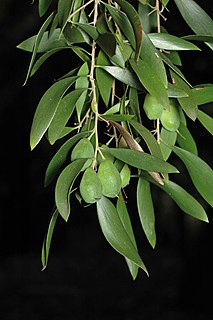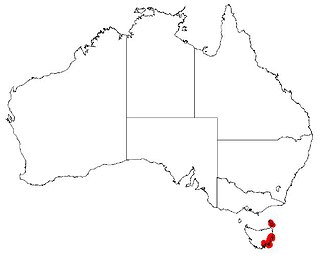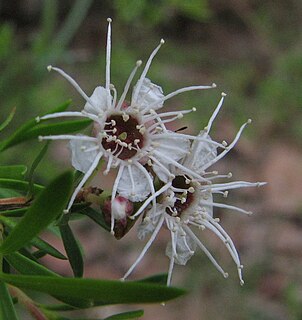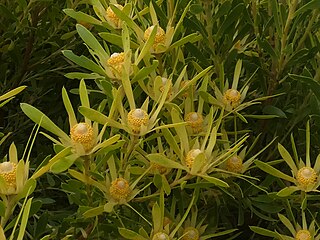
Griselinia littoralis, commonly known as kapuka, New Zealand broadleaf or pāpāuma, is a fast-growing small to medium-sized evergreen tree that is native to New Zealand.

The mountain degu is a species of rodent in the family Octodontidae. It is the only species in the genus Octodontomys. It is found in the foothills of the Andes in Argentina, Bolivia and Chile.

Eucalyptus coccifera, commonly known as the Tasmanian snow gum, is a small to medium-sized tree endemic to Tasmania. It has smooth, grey and cream-coloured bark, elliptic to lance-shaped adult leaves, flower buds in groups of between three and nine, usually white flowers and conical, hemispherical or cup-shaped fruit.

Mimetes hirtus is an upright, evergreen shrub of 1½–2 m high from the family Proteaceae. It has upright, overlapping, (broadly) lance-shaped leaves, without teeth, but with one thickened pointy tip. It has cylindric inflorescences topped by a pine apple-like tuft of pinkish-brownish, smaller and more or less horizontal leaves. The flowerheads are tightly enclosed by yellow, red-tipped bracts, only the 9–14 long red styles and the whitish silky tips of the perianth sticking out. It is primarily pollinated by the Cape sugarbird. It is an endemic species of the southwest of the Western Cape province of South Africa, and grows in wet zones at the base of south facing mountain slopes. Flower heads may be found from May to November, but peaks in July and August. The species has several vernacular names of which marsh pagoda seems to be used most.
Kunzea peduncularis, commonly known as mountain burgan, is a flowering plant in Myrtaceae, the myrtle family, and is endemic to Victoria, Australia. It is usually a dense shrub and has lance-shaped to egg-shaped leaves with the narrower end towards the base. Dense groups of white flowers appear in early summer.

Myrceugenia obtusa, also known as raran, is an evergreen tree endemic to Chile from Coquimbo to Cautin. It grows mainly in the coastal mountains on moist sites.

Myrceugenia planipes, known as Valdivia's patagua is an evergreen found in Chile and Argentina from 37 to 45°S. It occurs between 400 (1300) and 700 m (2300 ft) above sea level.

Persoonia juniperina, commonly known as prickly geebung, is a species of flowering plant in the family Proteaceae and is endemic to south-eastern Australia. It is a small erect to low-lying shrub with smooth bark, hairy new branches, linear leaves, yellow flowers borne singly or in groups of up to forty in leaf axils, and yellowish green to purplish fruit.

Xylomelum occidentale, commonly known as the western woody pear, is a tree species in the family Proteaceae. It is endemic to Western Australia.

Persoonia gunnii is a species of flowering plant in the family Proteaceae and is endemic to Tasmania. It is an erect shrub with young branchlets that are hairy at first, spatula-shaped to egg-shaped leaves with the narrower end towards the base, and white to cream-coloured flowers.
Myrceugenia rufa is a species of shrub in the genus Myrceugenia of the family Myrtaceae. It is endemic to Chile, where it grows in forest remnants near the coast and is considered "endangered".
Myrceugenia colchaguensis is a species of small evergreen tree in the genus Myrceugenia of the family Myrtaceae. It is endemic to Chile where it is found in the coastal mountain range at altitudes below 400 m (1,312 ft). Common names by which this tree is known include colchaguillo, arrayan de colchagua and lumilla.

Persoonia amaliae is a species of flowering plant in the family Proteaceae and is endemic to Queensland. It is a shrub or small tree with hairy young branches, spatula-shaped to lance-shaped leaves and yellow flowers in groups of up to eleven.

Hakea lissosperma, commonly known as needle bush and mountain needlewood, is a species of Hakea native to parts of south eastern Australia.

Hakea megadenia is a shrub or tree of the family Proteacea endemic to an area along the east coast of Tasmania and the Furneaux Island group off the coast of Tasmania.

Kunzea leptospermoides, commonly known as Yarra burgan, is a flowering plant in Myrtaceae, the myrtle family, and is endemic to Victoria, Australia. It is an erect shrub or small tree with narrow leaves and white flowers crowded near the ends of the branches in spring.

Leucadendron coniferum, also known at the dune conebush, is an evergreen, dioecious shrub or small tree of up to 4 m (13 ft) high, that has been assigned to the family Proteaceae. It has a whorl of conspicuous yellow leaves subtending the flowerheads. The flowers can be found in August and September. It grows in sandy soils near the coast of the Western Cape province of South Africa.

Leucospermum muirii is a rounded, upright, evergreen shrub of about 1½ m (5 ft) high, with a single trunk at its base, that is assigned to the Proteaceae. The flowering branches are 2–3 mm (0.079–0.118 in) thick and are initially grey due to a covering of fine crinkly hairs, which are soon lost. The very narrow spade-shaped leaves of about 5 cm (2 in) long and ¾ cm (0.3 in) wide carry three to seven teeth, and also quickly lose their soft layer of hairs. Its smallish globe-shaped flower heads of 2–3 cm (0.8–1.2 in) in diameter occur with one to four together, each on a stalk of 1–2 cm (0.4–0.8 in) long. It has pale to greenish yellow flowers, becoming orange with age, with some long hairs near their tips, from which straight styles stick out. This gives the flower head the likeness of a pincushion. It flowers from July till October and is pollinated by birds. It is called Albertinia pincushion in English and bloukoolhout in Afrikaans. It is an endemic species that can only be found near Albertinia in the very south of the Western Cape province of South Africa.

Vexatorella obtusata is an evergreen shrub, with narrow, leathery leaves and about 2 cm big, globular flowerheads consisting of well scented, creamy pink flowers, from which a long style with a thickened tip extends. Two subspecies are distinguished, both restricted to different parts of the Western Cape province of South Africa. The creeping V. obtusata subsp. obtusata, also known as the Montagu vexator flowers from September to December, and the upright V. obtusata subsp. albomontana, also known as the Witteberg vexator, that has flowers between August and November.

Barringtonia edulis is a species of tree with edible fruits from the southwestern Pacific region, being found on Fiji and Vanuatu. Common names include cut nut, pao nut, boxfruit tree, heart tree, and yum-yum tree.

















